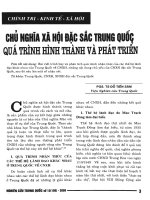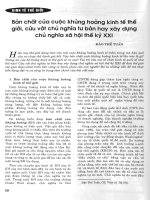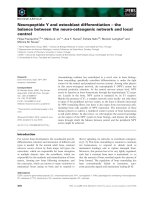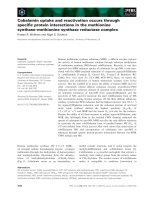Tài liệu Báo cáo khoa học: "Better Filtration and Augmentation for Hierarchical Phrase-Based Translation Rules" pdf
Bạn đang xem bản rút gọn của tài liệu. Xem và tải ngay bản đầy đủ của tài liệu tại đây (153.71 KB, 5 trang )
Proceedings of the ACL 2010 Conference Short Papers, pages 142–146,
Uppsala, Sweden, 11-16 July 2010.
c
2010 Association for Computational Linguistics
Better Filtration and Augmentation for Hierarchical Phrase-Based
Translation Rules
Zhiyang Wang
†
Yajuan L
¨
u
†
Qun Liu
†
Young-Sook Hwang
‡
†
Key Lab. of Intelligent Information Processing
‡
HILab Convergence Technology Center
Institute of Computing Technology C&I Business
Chinese Academy of Sciences SKTelecom
P.O. Box 2704, Beijing 100190, China 11, Euljiro2-ga, Jung-gu, Seoul 100-999, Korea
Abstract
This paper presents a novel filtration cri-
terion to restrict the rule extraction for
the hierarchical phrase-based translation
model, where a bilingual but relaxed well-
formed dependency restriction is used to
filter out bad rules. Furthermore, a new
feature which describes the regularity that
the source/target dependency edge trig-
gers the target/source word is also pro-
posed. Experimental results show that, the
new criteria weeds out about 40% rules
while with translation performance im-
provement, and the new feature brings an-
other improvement to the baseline system,
especially on larger corpus.
1 Introduction
Hierarchical phrase-based (HPB) model (Chiang,
2005) is the state-of-the-art statistical machine
translation (SMT) model. By looking for phrases
that contain other phrases and replacing the sub-
phrases with nonterminal symbols, it gets hierar-
chical rules. Hierarchical rules are more powerful
than conventional phrases since they have better
generalization capability and could capture long
distance reordering. However, when the train-
ing corpus becomes larger, the number of rules
will grow exponentially, which inevitably results
in slow and memory-consuming decoding.
In this paper, we address the problem of reduc-
ing the hierarchical translation rule table resorting
to the dependency information of bilingual lan-
guages. We only keep rules that both sides are
relaxed-well-formed (RWF) dependency structure
(see the definition in Section 3), and discard others
which do not satisfy this constraint. In this way,
about 40% bad rules are weeded out from the orig-
inal rule table. However, the performance is even
better than the traditional HPB translation system.
Source
Target
f
f’
e
Figure 1: Solid wire reveals the dependency rela-
tion pointing from the child to the parent. Target
word e is triggered by the source word f and it’s
head word f
′
, p(e|f → f
′
).
Based on the relaxed-well-formed dependency
structure, we also introduce a new linguistic fea-
ture to enhance translation performance. In the
traditional phrase-based SMT model, there are
always lexical translation probabilities based on
IBM model 1 (Brown et al., 1993), i.e. p(e|f),
namely, the target word e is triggered by the source
word f. Intuitively, however, the generation of e
is not only involved with f, sometimes may also
be triggered by other context words in the source
side. Here we assume that the dependency edge
(f → f
′
) of word f generates target word e (we
call it head word trigger in Section 4). Therefore,
two words in one language trigger one word in
another, which provides a more sophisticated and
better choice for the target word, i.e. Figure 1.
Similarly, the dependency feature works well in
Chinese-to-English translation task, especially on
large corpus.
2 Related Work
In the past, a significant number of techniques
have been presented to reduce the hierarchical rule
table. He et al. (2009) just used the key phrases
of source side to filter the rule table without taking
advantage of any linguistic information. Iglesias
et al. (2009) put rules into syntactic classes based
on the number of non-terminals and patterns, and
applied various filtration strategies to improve the
rule table quality. Shen et al. (2008) discarded
142
found
The
girl
lovely
house
a beautiful
Figure 2: An example of dependency tree. The
corresponding plain sentence is The lovely girl
found a beautiful house.
most entries of the rule table by using the con-
straint that rules of the target-side are well-formed
(WF) dependency structure, but this filtering led to
degradation in translation performance. They ob-
tained improvements by adding an additional de-
pendency language model. The basic difference
of our method from (Shen et al., 2008) is that we
keep rules that both sides should be relaxed-well-
formed dependency structure, not just the target
side. Besides, our system complexity is not in-
creased because no additional language model is
introduced.
The feature of head word trigger which we ap-
ply to the log-linear model is motivated by the
trigger-based approach (Hasan and Ney, 2009).
Hasan and Ney (2009) introduced a second word
to trigger the target word without considering any
linguistic information. Furthermore, since the sec-
ond word can come from any part of the sentence,
there may be a prohibitively large number of pa-
rameters involved. Besides, He et al. (2008) built
a maximum entropy model which combines rich
context information for selecting translation rules
during decoding. However, as the size of the cor-
pus increases, the maximum entropy model will
become larger. Similarly, In (Shen et al., 2009),
context language model is proposed for better rule
selection. Taking the dependency edge as condi-
tion, our approach is very different from previous
approaches of exploring context information.
3 Relaxed-well-formed Dependency
Structure
Dependency models have recently gained consid-
erable interest in SMT (Ding and Palmer, 2005;
Quirk et al., 2005; Shen et al., 2008). Depen-
dency tree can represent richer structural infor-
mation. It reveals long-distance relation between
words and directly models the semantic structure
of a sentence without any constituent labels. Fig-
ure 2 shows an example of a dependency tree. In
this example, the word found is the root of the tree.
Shen et al. (2008) propose the well-formed de-
pendency structure to filter the hierarchical rule ta-
ble. A well-formed dependency structure could be
either a single-rooted dependency tree or a set of
sibling trees. Although most rules are discarded
with the constraint that the target side should be
well-formed, this filtration leads to degradation in
translation performance.
As an extension of the work of (Shen et
al., 2008), we introduce the so-called relaxed-
well-formed dependency structure to filter the hi-
erarchical rule table. Given a sentence S =
w
1
w
2
w
n
. Let d
1
d
2
d
n
represent the position of
parent word for each word. For example, d
3
= 4
means that w
3
depends on w
4
. If w
i
is a root, we
define d
i
= −1.
Definition A dependency structure w
i
w
j
is
a relaxed-well-formed structure, where there is
h /∈ [i, j], all the words w
i
w
j
are directly or
indirectly depended on w
h
or -1 (here we define
h = −1). If and only if it satisfies the following
conditions
• d
h
/∈ [i, j]
• ∀k ∈ [i, j], d
k
∈ [i, j] or d
k
= h
From the definition above, we can see that
the relaxed-well-formed structure obviously cov-
ers the well-formed one. In this structure, we
don’t constrain that all the children of the sub-root
should be complete. Let’s review the dependency
tree in Figure 2 as an example. Except for the well-
formed structure, we could also extract girl found
a beautiful house. Therefore, if the modifier The
lovely changes to The cute, this rule also works.
4 Head Word Trigger
(Koehn et al., 2003) introduced the concept of
lexical weighting to check how well words of
the phrase translate to each other. Source word
f aligns with target word e, according to the
IBM model 1, the lexical translation probability
is p(e|f). However, in the sense of dependency
relationship, we believe that the generation of the
target word e, is not only triggered by the aligned
source word f, but also associated with f ’s head
word f
′
. Therefore, the lexical translation prob-
ability becomes p(e|f → f
′
), which of course
allows for a more fine-grained lexical choice of
143
the target word. More specifically, the probabil-
ity could be estimated by the maximum likelihood
(MLE) approach,
p(e|f → f
′
) =
count(e, f → f
′
)
e
′
count(e
′
, f → f
′
)
(1)
Given a phrase pair f , e and word alignment
a, and the dependent relation of the source sen-
tence d
J
1
(J is the length of the source sentence,
I is the length of the target sentence). Therefore,
given the lexical translation probability distribu-
tion p(e|f → f
′
), we compute the feature score of
a phrase pair (f , e) as
p(e|f, d
J
1
, a)
= Π
|e|
i=1
1
|{j|(j, i) ∈ a}|
∀(j,i)∈a
p(e
i
|f
j
→ f
d
j
)
(2)
Now we get p(e|f, d
J
1
, a), we could obtain
p(f|e, d
I
1
, a) (d
I
1
represents dependent relation of
the target side) in the similar way. This new fea-
ture can be easily integrated into the log-linear
model as lexical weighting does.
5 Experiments
In this section, we describe the experimental set-
ting used in this work, and verify the effect of
the relaxed-well-formed structure filtering and the
new feature, head word trigger.
5.1 Experimental Setup
Experiments are carried out on the NIST
1
Chinese-English translation task with two differ-
ent size of training corpora.
• FBIS: We use the FBIS corpus as the first
training corpus, which contains 239K sen-
tence pairs with 6.9M Chinese words and
8.9M English words.
• GQ: This is manually selected from the
LDC
2
corpora. GQ contains 1.5M sentence
pairs with 41M Chinese words and 48M En-
glish words. In fact, FBIS is the subset of
GQ.
1
www.nist.gov/speech/tests/mt
2
It consists of six LDC corpora:
LDC2002E18, LDC2003E07, LDC2003E14, Hansards part
of LDC2004T07, LDC2004T08, LDC2005T06.
For language model, we use the SRI Language
Modeling Toolkit (Stolcke, 2002) to train a 4-
gram model on the first 1/3 of the Xinhua portion
of GIGAWORD corpus. And we use the NIST
2002 MT evaluation test set as our development
set, and NIST 2004, 2005 test sets as our blind
test sets. We evaluate the translation quality us-
ing case-insensitive BLEU metric (Papineni et
al., 2002) without dropping OOV words, and the
feature weights are tuned by minimum error rate
training (Och, 2003).
In order to get the dependency relation of the
training corpus, we re-implement a beam-search
style monolingual dependency parser according
to (Nivre and Scholz, 2004). Then we use the
same method suggested in (Chiang, 2005) to
extract SCFG grammar rules within dependency
constraint on both sides except that unaligned
words are allowed at the edge of phrases. Pa-
rameters of head word trigger are estimated as de-
scribed in Section 4. As a default, the maximum
initial phrase length is set to 10 and the maximum
rule length of the source side is set to 5. Besides,
we also re-implement the decoder of Hiero (Chi-
ang, 2007) as our baseline. In fact, we just exploit
the dependency structure during the rule extrac-
tion phase. Therefore, we don’t need to change
the main decoding algorithm of the SMT system.
5.2 Results on FBIS Corpus
A series of experiments was done on the FBIS cor-
pus. We first parse the bilingual languages with
monolingual dependency parser respectively, and
then only retain the rules that both sides are in line
with the constraint of dependency structure. In
Table 1, the relaxed-well-formed structure filtered
out 35% of the rule table and the well-formed dis-
carded 74%. RWF extracts additional 39% com-
pared to WF, which can be seen as some kind
of evidence that the rules we additional get seem
common in the sense of linguistics. Compared to
(Shen et al., 2008), we just use the dependency
structure to constrain rules, not to maintain the tree
structures to guide decoding.
Table 2 shows the translation result on FBIS.
We can see that the RWF structure constraint can
improve translation quality substantially both at
development set and different test sets. On the
Test04 task, it gains +0.86% BLEU, and +0.84%
on Test05. Besides, we also used Shen et al.
(2008)’s WF structure to filter both sides. Al-
though it discard about 74% of the rule table, the
144
System Rule table size
HPB 30,152,090
RWF 19,610,255
WF 7,742,031
Table 1: Rule table size with different con-
straint on FBIS. Here HPB refers to the base-
line hierarchal phrase-based system, RWF means
relaxed-well-formed constraint and WF represents
the well-formed structure.
System Dev02 Test04 Test05
HPB 0.3285 0.3284 0.2965
WF 0.3125 0.3218 0.2887
RWF 0.3326 0.3370** 0.3050
RWF+Tri 0.3281 / 0.2965
Table 2: Results of FBIS corpus. Here Tri means
the feature of head word trigger on both sides. And
we don’t test the new feature on Test04 because of
the bad performance on development set. * or **
= significantly better than baseline (p < 0.05 or
0.01, respectively).
over-all BLEU is decreased by 0.66%-0.78% on
the test sets.
As for the feature of head word trigger, it seems
not work on the FBIS corpus. On Test05, it gets
the same score with the baseline, but lower than
RWF filtering. This may be caused by the data
sparseness problem, which results in inaccurate
parameter estimation of the new feature.
5.3 Result on GQ Corpus
In this part, we increased the size of the training
corpus to check whether the feature of head word
trigger works on large corpus.
We get 152M rule entries from the GQ corpus
according to (Chiang, 2007)’s extraction method.
If we use the RWF structure to constrain both
sides, the number of rules is 87M, about 43% of
rule entries are discarded. From Table 3, the new
System Dev02 Test04 Test05
HPB 0.3473 0.3386 0.3206
RWF 0.3539 0.3485** 0.3228
RWF+Tri 0.3540 0.3607** 0.3339*
Table 3: Results of GQ corpus. * or ** = sig-
nificantly better than baseline (p < 0.05 or 0.01,
respectively).
feature works well on two different test sets. The
gain is +2.21% BLEU on Test04, and +1.33% on
Test05. Compared to the result of the baseline,
only using the RWF structure to filter performs the
same as the baseline on Test05, and +0.99% gains
on Test04.
6 Conclusions
This paper proposes a simple strategy to filter the
hierarchal rule table, and introduces a new feature
to enhance the translation performance. We em-
ploy the relaxed-well-formed dependency struc-
ture to constrain both sides of the rule, and about
40% of rules are discarded with improvement of
the translation performance. In order to make full
use of the dependency information, we assume
that the target word e is triggered by dependency
edge of the corresponding source word f. And
this feature works well on large parallel training
corpus.
How to estimate the probability of head word
trigger is very important. Here we only get the pa-
rameters in a generative way. In the future, we we
are plan to exploit some discriminative approach
to train parameters of this feature, such as EM al-
gorithm (Hasan et al., 2008) or maximum entropy
(He et al., 2008).
Besides, the quality of the parser is another ef-
fect for this method. As the next step, we will
try to exploit bilingual knowledge to improve the
monolingual parser, i.e. (Huang et al., 2009).
Acknowledgments
This work was partly supported by National
Natural Science Foundation of China Contract
60873167. It was also funded by SK Telecom,
Korea under the contract 4360002953. We show
our special thanks to Wenbin Jiang and Shu Cai
for their valuable suggestions. We also thank
the anonymous reviewers for their insightful com-
ments.
References
Peter F. Brown, Vincent J. Della Pietra, Stephen
A. Della Pietra, and Robert L. Mercer. 1993. The
mathematics of statistical machine translation: pa-
rameter estimation. Comput. Linguist., 19(2):263–
311.
David Chiang. 2005. A hierarchical phrase-based
model for statistical machine translation. In ACL
145
’05: Proceedings of the 43rd Annual Meeting on As-
sociation for Computational Linguistics, pages 263–
270.
David Chiang. 2007. Hierarchical phrase-based trans-
lation. Comput. Linguist., 33(2):201–228.
Yuan Ding and Martha Palmer. 2005. Machine trans-
lation using probabilistic synchronous dependency
insertion grammars. In ACL ’05: Proceedings of the
43rd Annual Meeting on Association for Computa-
tional Linguistics, pages 541–548.
Saˇsa Hasan and Hermann Ney. 2009. Comparison of
extended lexicon models in search and rescoring for
smt. In NAACL ’09: Proceedings of Human Lan-
guage Technologies: The 2009 Annual Conference
of the North American Chapter of the Association
for Computational Linguistics, Companion Volume:
Short Papers, pages 17–20.
Saˇsa Hasan, Juri Ganitkevitch, Hermann Ney, and
Jes´us Andr´es-Ferrer. 2008. Triplet lexicon models
for statistical machine translation. In EMNLP ’08:
Proceedings of the Conference on Empirical Meth-
ods in Natural Language Processing, pages 372–
381.
Zhongjun He, Qun Liu, and Shouxun Lin. 2008. Im-
proving statistical machine translation using lexical-
ized rule selection. In COLING ’08: Proceedings
of the 22nd International Conference on Computa-
tional Linguistics, pages 321–328.
Zhongjun He, Yao Meng, Yajuan L¨u, Hao Yu, and Qun
Liu. 2009. Reducing smt rule table with monolin-
gual key phrase. In ACL-IJCNLP ’09: Proceedings
of the ACL-IJCNLP 2009 Conference Short Papers,
pages 121–124.
Liang Huang, Wenbin Jiang, and Qun Liu. 2009.
Bilingually-constrained (monolingual) shift-reduce
parsing. In EMNLP ’09: Proceedings of the 2009
Conference on Empirical Methods in Natural Lan-
guage Processing, pages 1222–1231.
Gonzalo Iglesias, Adri`a de Gispert, Eduardo R. Banga,
and William Byrne. 2009. Rule filtering by pattern
for efficient hierarchical translation. In EACL ’09:
Proceedings of the 12th Conference of the European
Chapter of the Association for Computational Lin-
guistics, pages 380–388.
Philipp Koehn, Franz Josef Och, and Daniel Marcu.
2003. Statistical phrase-based translation. In
NAACL ’03: Proceedings of the 2003 Conference
of the North American Chapter of the Association
for Computational Linguistics on Human Language
Technology, pages 48–54.
Joakim Nivre and Mario Scholz. 2004. Determinis-
tic dependency parsing of english text. In COLING
’04: Proceedings of the 20th international confer-
ence on Computational Linguistics, pages 64–70.
Franz Josef Och. 2003. Minimum error rate training
in statistical machine translation. In ACL ’03: Pro-
ceedings of the 41st Annual Meeting on Association
for Computational Linguistics, pages 160–167.
Kishore Papineni, Salim Roukos, Todd Ward, and Wei-
Jing Zhu. 2002. Bleu: a method for automatic eval-
uation of machine translation. In ACL ’02: Proceed-
ings of the 40th Annual Meeting on Association for
Computational Linguistics, pages 311–318.
Chris Quirk, Arul Menezes, and Colin Cherry. 2005.
Dependency treelet translation: syntactically in-
formed phrasal smt. In ACL ’05: Proceedings of
the 43rd Annual Meeting on Association for Com-
putational Linguistics, pages 271–279.
Libin Shen, Jinxi Xu, and Ralph Weischedel. 2008. A
new string-to-dependency machine translation algo-
rithm with a target dependency language model. In
Proceedings of ACL-08: HLT, pages 577–585.
Libin Shen, Jinxi Xu, Bing Zhang, Spyros Matsoukas,
and Ralph Weischedel. 2009. Effective use of lin-
guistic and contextual information for statistical ma-
chine translation. In EMNLP ’09: Proceedings of
the 2009 Conference on Empirical Methods in Nat-
ural Language Processing, pages 72–80.
Andreas Stolcke. 2002. Srilman extensible language
modeling toolkit. In In Proceedings of the 7th Inter-
national Conference on Spoken Language Process-
ing (ICSLP 2002), pages 901–904.
146









